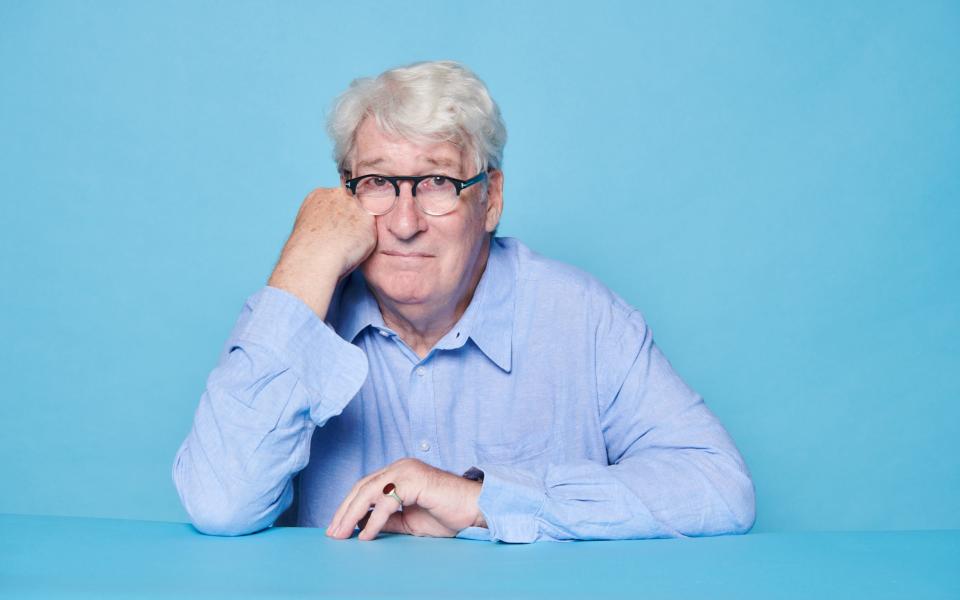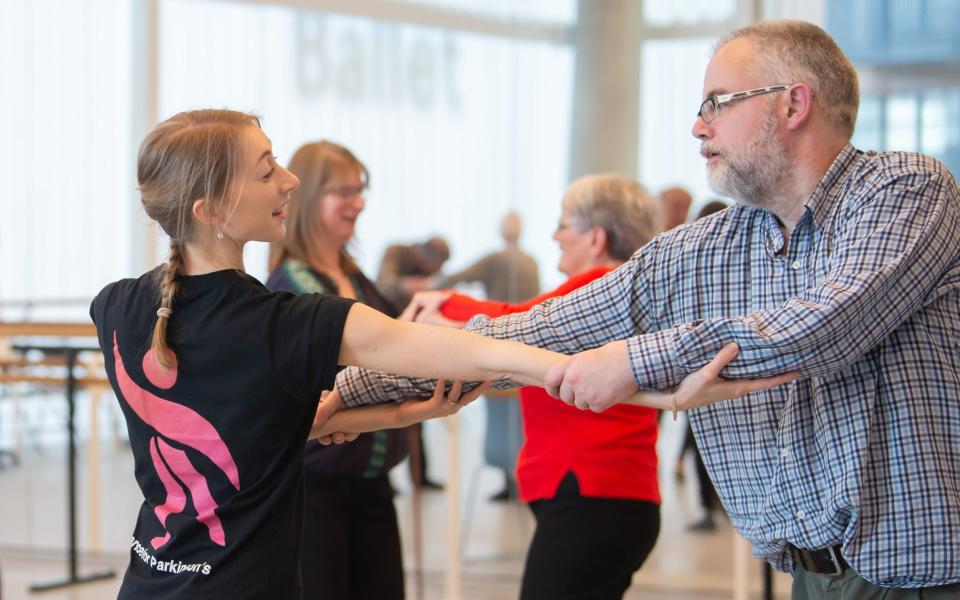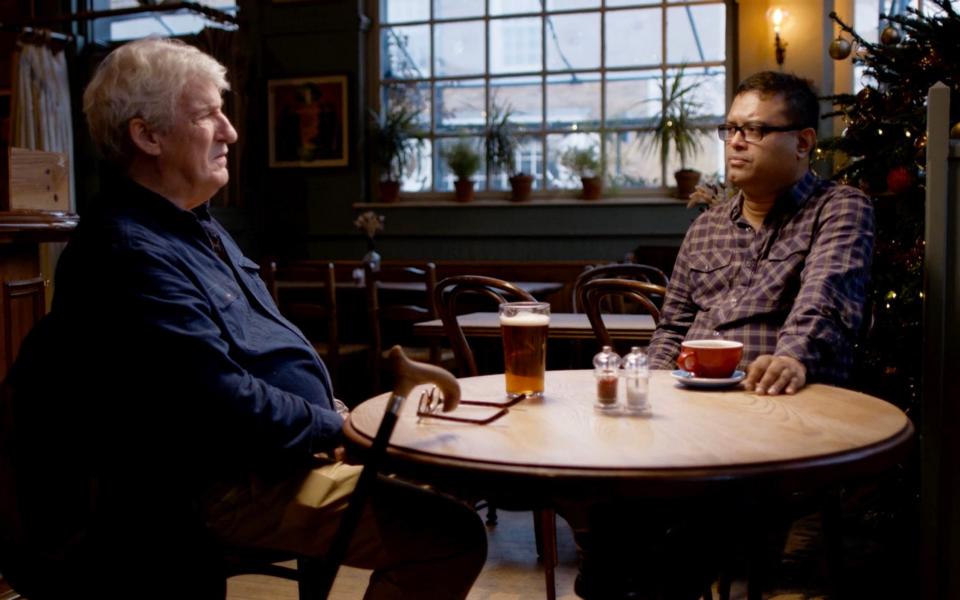The ballet company helping Jeremy Paxman with his Parkinson’s

- Oops!Something went wrong.Please try again later.
- Oops!Something went wrong.Please try again later.
- Oops!Something went wrong.Please try again later.
In a dance studio in east London, Jeremy Paxman – yes, that Paxman of Newsnight and University Challenge fame – is sitting on a chair awkwardly moving his arms into ballet’s second position, then above his head in fifth. “Here we go!” cries a teacher above a piano playing the Hungarian dance from the ballet Raymonda. “And one! And around! Strike that match!” Paxman waves his arms in front of his face and kicks his feet out one after the other. Then he – along with 20-or-so classmates – gingerly flutters his fingers in the air, before uncertainly shuffling around the room, one arm above his head, one behind his back as in a flamenco.
For Eeyorish Paxman, 72, taking up dance seems about as unlikely as him declaring a passion for the Kardashians. Yet ballet is one of the activities recommended for Parkinson’s disease, which he investigates in a new, one-off ITV documentary Paxman: Putting Up With Parkinson’s (a title he insisted on, rejecting the clichéd “living with Parkinson’s”) after being diagnosed with the disease last year.
The class he is attending has been organised by English National Ballet (ENB), which, for 12 years, has been running sessions for people with Parkinson’s, as well as their carers, at nine venues across England and Wales and on Zoom, for a “nominal” cost of about £4 a class.
Research by the University of Roehampton published in 2015 showed that dance can – among many things – help temporarily relieve the symptoms of Parkinson’s, a disease that affects around 145,000 people in the UK. Dance also boosts balance, postural stability, fluidity of movement and flexibility of the spine. The classes include vocal and facial work.
“People with Parkinson’s often lose the ability to express themselves through facial movement and their voices get quieter, so these [exercises] really encourage the use of those muscles,” says Laura Harvey, ENB’s head of creative programming.

Yet, Harvey stresses that the ballet isn’t physical therapy per se, but more a much-needed outlet for self-expression “with therapeutic benefits”.
“When people living with Parkinson’s come to us, they don’t want to talk about therapy or their Parkinson’s, they want an artistic experience, and that can be transformative. Even in quite a short amount of time, participants are playing other characters and that allows them to leave their Parkinson’s at the door, ” she says. “People often find, by using imagery and narrative rather than, say, the bland language of a physiotherapy session, that they’re more able to do something like lifting their arm because their mind is somewhere else and their bodies just move for them.”
Paul Mayhew-Archer, 69, the actor, screenwriter and producer best known for co-writing The Vicar of Dibley, was diagnosed with Parkinson’s 11 years ago. He fully agrees with Harvey’s description. “We’re thinking so hard about what we’re doing that I forget I have Parkinson’s for hours and that’s fantastic,” he tells his friend Paxman, whom he accompanies to ENB’s Dance for Parkinson’s class in the documentary.
“Dance for Parkinson’s is absolutely marvellous because music gets to you somewhere deep down in the brain. It stirs memories that we’d forgotten all about and can get us physically moving,” Mayhew-Archer, who has attended the classes in Oxford for the past seven years, tells me later. “It’s very important, because one of the symptoms we people with Parkinson’s can get is freezing episodes when your legs literally stop – it’s particularly difficult if you’re on a train and the doors open and you can’t get off. I’ve found the best thing to do to get going is to try and get a dance rhythm going – one, two, three, four.”
These classes are very far from patronising old-folk music-and-movement sessions. Instead, “dancers”, as participants are called – whose ages range from 30 to 80-plus, all at different stages of the disease – are held to a high standard, each term tackling scenes from ENB’s repertoire – anything from Romeo and Juliet to Akram Khan’s Giselle.

“The teachers are trained to really keep pushing forward, to take people further than they think they are capable of. We don’t see it as what they can’t do but what they can do,” says Harvey. “Jeremy only came in for one class, whereas we’ve had dancers who’ve been with us for a long time and are doing quite complex sequences, so it may have been a little overwhelming. There’s skill involved in what they’re doing and they have a drive to maintain that high quality.”
Certainly, Paxman appears at worst uneasy, at best bemused by the class. “I enjoyed it very much,” he tells his classmates, but then adds: “I thought it would be very embarrassing and it was. I felt a bit of a fool.” Dancing, he complains, “doesn’t make [Parkinson’s] any better. It just stops it getting worse”. Later in the film, he refers to dancing as “something horrible”.
Overall, Paxman, who – to the viewer – only appears somewhat stiff of gait, is reluctant to reveal how “f---ing Parkinson’s” is affecting him, except to admit, “I can’t type – that’s really annoying. I think I’ve written something and it turns out to be gibberish… it gets me down a bit.”
He’s seen struggling to do up buttons and recalls how he was diagnosed after falling over several times, “with no recollection of how it had happened”. One fall landed him in A&E – a doctor told him that while watching him on University Challenge he’d noticed his face had acquired the unexpressive “Parkinson’s Mask”. “It is immensely frustrating,” he says.
Depression is a common Parkinson’s symptom, and Paxman admits to his consultant neurologist that prescribed “mood-enhancers” have stopped him “feeling as depressed as I did”. He now describes his mood as “wryly amused”, and states, “I don’t want people’s sympathy.”

Having met Paxman previously when he was working on a University Challenge sketch for Comic Relief, Mayhew-Archer contacted him after hearing about his diagnosis. “Though it was a bit embarrassing because my predictive text changed ‘Thank you so much’ to ‘Smooch’,” he says. The men, together with the BBC’s former technology correspondent Rory Cellan-Jones, who also has the disease, meet occasionally for lunch. “We have a good chat and see how we’re doing. You have to talk to other people.”
In the documentary, Paxman, who will film his final episode of University Challenge this month, looks at ways in which people with the disease can improve outcomes. They include physiotherapy, taking CBD oil and playing bowls. But he appears more depressed than enthused. “I’m beaten and I’m dejected,” he tells his physiotherapist.
When he meets Sharon Osbourne, whose husband Ozzy has the disease, she berates him for not exercising, telling him to “Get you’re a--- in gear”, and adding for good measure: “You’re a miserable old sod… I can just tell.”
Mayhew-Archer admits he has also criticised Paxman for his negative attitude. “I think if I had been someone who’d been grilling prime ministers [I] would [also] feel the loss of control more deeply,” he says.
At one point, Paxman wails, “It’s all doom and gloom.” Mayhew-Archer strongly disagrees. “A lot of people think Parkinson’s is the end of the world – it’s not. There’s lots of scientific research going on. And, meanwhile, things like dance are so wonderfully helpful. There is hope.”
Paxman: Putting Up with Parkinson’s airs on ITV on Tuesday at 9pm

